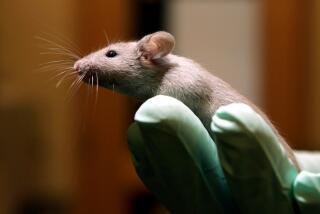Scientists take key step in stem cell therapy
- Share via
For the first time, scientists have used cloning techniques — inserting genetic material from adult cells into unfertilized human eggs — to create embryonic stem cells.
The advance, reported Wednesday in the journal Nature, moves scientists one step closer to their goal of developing therapies to treat maladies including diabetes, Alzheimer’s disease and Parkinson’s disease, researchers said.
In the world of stem cell research, the achievement marks an important step, but only a step.
The stem cells created by the team at the New York Stem Cell Foundation Laboratory in New York City and collaborators at Columbia University and UC San Diego were genetically abnormal, containing a mixture of DNA from the adult skin cells that were cloned and from the egg used in the procedure. That’s because the team bypassed a step in the process in which genetic material from the egg is removed.
They did so because, like others in the past, they were not able to get an embryo to develop to a sufficiently advanced stage if they removed the genetic material from the egg.
That hurdle must be overcome if anyone wants to use cloning technology to create stem cells suitable for therapeutic use, said Dieter Egli, a senior research fellow at the New York Stem Cell Foundation Laboratory, who led the study along with senior research fellow Scott Noggle.
Still, the research shows that somatic cell nuclear transfer, as the cloning procedure is technically called, could one day help create stem cell therapies tailored to prevent immune rejection, said Dr. Robert Lanza, an embryonic stem cell researcher at Advanced Cell Technology in Worcester, Mass.
“This is saying ‘It can be done,’ ” said Lanza, who was not involved in the study.
Physicians who would like to harness embryonic stem cells — which have the potential to develop into any type of cell in the body — to rebuild or replace diseased tissues and organs face a major problem: Such cells may be rejected by patients unless they’re a good genetic match. Stem cells made from cloning a patient’s own tissue would get around that problem.
Since 2006, researchers have been able to create well-matched stem cells without the use of either cloning or human embryos by genetically tweaking body cells and rewinding them to an embryonic state.
But although these so-called induced pluripotent stem cells are promising and avoid some of the ethical problems posed by use of human embryos, recent studies have shown that the reprogramming trick might raise a cancer risk and that the cells maintain some “memory” of their original state.
These glitches may make it difficult to use them to safely treat disease.
“As we’ve looked closely at those cells, they have some warts,” said Dr. George Q. Daley of the Stem Cell Transplantation program at Children’s Hospital Boston, who wrote an article accompanying the new study in Nature.
But, Daley added, pursuing both avenues of research — and finding out which one works better — carries the best chance of bringing treatments to patients as quickly as possible.
The next step for Egli and other researchers who hope to make stem cells from clones will be figuring out a way to take out the egg’s DNA but keep whatever it is within the egg that allowed the abnormal embryos to grow for long enough to make embryonic stem cells.
It is possible the missing factor is not the DNA itself but certain proteins within the egg’s nucleus, where the DNA is housed, Lanza said.
Lanza added that studying these cloned embryos to see exactly how the egg promotes growth may help scientists perfect the creation of safe and sufficiently versatile induced pluripotent stem cells.
“We don’t know which of these technologies is going to give you a line that will do the trick best,” he said. “All we need is one method.”
Neither the study authors nor other stem cell scientists who were interviewed said they had any interest in creating cloned human babies from the technology, a possible fallout from such work that — along with the use of human embryos — has shrouded the field in some controversy.
The scientists created two lines of stem cells, one of which was derived from a person with Type 1 diabetes.
The research was privately funded. The team paid women $8,000 to donate eggs. After donation, the women could choose to have their eggs used for research or for reproductive purposes.







